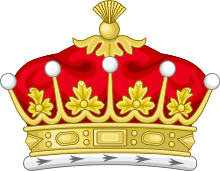Earl of Iveagh
| Earldom of Iveagh | |
|---|---|

| |
| Creation date | 30 September 1919 |
| Peerage | Peerage of the United Kingdom |
| First holder | Edward Guinness |
| Present holder | Edward Guinness, 4th Earl |
| Heir apparent | Arthur Guinness, Viscount Elveden |
| Subsidiary titles |
Viscount Elveden Viscount Iveagh Baron Iveagh |
| Seat(s) | Elveden Hall |
Earl of Iveagh (commonly pronounced "eye-vee" (especially in Dublin) or more correctly "eye-vah"[1][2]) is a noble title in the Peerage of the United Kingdom. It was created in 1919 for the businessman and philanthropist Edward Guinness, 1st Viscount Iveagh. He was the third son of Sir Benjamin Guinness, 1st Baronet, of Ashford, and the great-grandson of Arthur Guinness, the founder of the Guinness brewery.
Guinness had already been created a baronet, of Castle Knock in the County of Dublin, in 1885. He was subsequently made Baron Iveagh, of Iveagh in the County of Down, in 1891, then Viscount Iveagh, of Iveagh in the County of Down, in 1905, and was made Viscount Elveden, of Elveden in the County of Suffolk, at the same time that he was given the earldom in 1919.
As of 2015, the titles are held by his great-great-grandson, the fourth Earl, who succeeded his father in 1992. As a descendant of the first Guinness Baronet of Ashford, he is also in remainder to that title.
The Conservative politician Walter Guinness, 1st Baron Moyne, was the third son of the first Earl.
The family seat is Elveden Hall, near Elveden, Suffolk.
Earls of Iveagh (1919)

1st Earl of Iveagh
- Edward Cecil Guinness, 1st Earl of Iveagh (1847–1927)
- Rupert Edward Cecil Lee Guinness, 2nd Earl of Iveagh (1874–1967)
- (Arthur Francis) Benjamin Guinness, 3rd Earl of Iveagh (1937–1992)
- (Arthur) Edward Rory Guinness, 4th Earl of Iveagh (b. 1969)
The heir apparent is the present holder's son Arthur Benjamin Geoffrey Guinness, Viscount Elveden (b. 2003).
Arms
  |
|
See also
Notes
- ↑ Arthur Guinness and Dublin's Iveagh legacy. Retrieved on 2012-01-11 from http://www.hidden-dublin.com/foot/foot10.html.
- ↑ Pronunciation of Surnames from the book Enquire Within Upon Everything. 119th Edition, March 1939. Retrieved on 2012-01-11 from http://freepages.genealogy.rootsweb.ancestry.com/~sooty/pronoun.html.
References
- Kidd, Charles, Williamson, David (editors). Debrett's Peerage and Baronetage (1990 edition). New York: St Martin's Press, 1990,
- Leigh Rayment's Peerage Pages